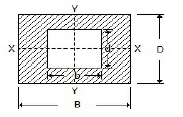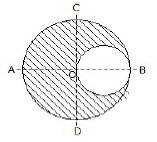If a given force (or a given system of forces) acting on a body __________ the position of the body, but keeps it in equilibrium, then its effect is to produce internal stress in the body.
Change
Does not change
Changes periodically
None of these
Correct Answer :
B. Does not change
Related Questions
The linear velocity of a body rotating at ω rad/s along a circular path of radius r is given by
ω/r
ω.r
ω2/r
ω2.r
D' Alembert's principle is used for
Reducing the problem of kinetics to equivalent statics problem
Determining stresses in the truss
Stability of floating bodies
Designing safe structures
Moment of inertia of a hollow rectangular section as shown in the below figure about X-X axis, is 
(BD³/12) - (bd³/12)
(DB³/12) - (db³/12)
(BD³/36) - (bd³/36)
(DB³/36) - (db³/36)
Coplanar concurrent forces are those forces which
Meet at one point, but their lines of action do not lie on the same plane
Do not meet at one point and their lines of action do not lie on the same plane
Meet at one point and their lines of action also lie on the same plane
Do not meet at one point, but their lines of action lie on the same plane
Two balls of equal mass and of perfectly elastic material are lying on the floor. One of the balls with velocity v is made to strike the second ball. Both the balls after impact will move with a velocity
v
v/2
v/4
v/8
If a body is acted upon by a number of coplanar non-concurrent forces, it may
Rotate about itself without moving
Move in any one direction rotating about itself
Be completely at rest
All of these
The resultant of two forces P and Q acting at an angle θ is
√(P² + Q² + 2PQ sinθ)
√(P² + Q² + 2PQ cosθ)
√(P² + Q² - 2PQ cosθ)
√(P² + Q² - 2PQ tanθ)
In the lever of third order, load W, effort P and fulcrum F are oriented as follows
W between P and F
F between W and P
P between W and F
W, P and F all on one side
Joule is the unit of
Force
Work
Power
Velocity
A heavy string attached at two ends at same horizontal level and when central dip is very small approaches the following curve
Circular arc
Parabola
Hyperbola
Elliptical
The acceleration of a particle moving with simple harmonic motion is __________ at the mean position.
Zero
Minimum
Maximum
None of these
A circular hole of 50 mm diameter is cut out from a circular disc of 100 mm diameter as shown in the below figure. The centre of gravity of the section will lie 
In the shaded area
In the hole
At O
None of these
Moment of inertia of a rectangular section having width (b) and depth (d) about an axis passing through its C.G. and parallel to the depth (d), is
db3/12
bd³/12
db³/36
bd³/36
The coefficient of friction depends upon
Nature of surfaces
Area of contact
Shape of the surfaces
All of the above
If rain is falling in the opposite direction of the movement of a pedestrian, he has to hold his umbrella
More inclined when moving
Less inclined when moving
More inclined when standing
Less inclined when standing
An ideal machine is one whose efficiency is
Between 60 and 70 %
Between 70 and 80 %
Between 80 and 90 %
100 %
The forces, whose lines of action are parallel to each other and act in the same directions, are known as
Coplanar concurrent forces
Coplanar non-concurrent forces
Like parallel forces
Unlike parallel forces
Which of the following is an equation of linear motion? (where, u and v = Initial and final velocity of the body, a = Acceleration of the body, and s = Displacement of the body in time t seconds.)
v = u + a.t
s = u.t + ½ a.t2
v2 = u2 + 2a.s
All of these
The force applied on a body of mass 100 kg to produce an acceleration of 5 m/s2, is
20 N
100 N
500 N
None of these
A trolley wire weighs 1.2 kg per meter length. The ends of the wire are attached to two poles 20 meters apart. If the horizontal tension is 1500 kg find the dip in the middle of the span
2.5 cm
3.0 cm
4.0 cm
5.0 cm
In a framed structure, as shown in the below figure, the forces in the members AB and BC are respectively 
√3. W (tensile) and 2W (compressive)
2W (tensile) and √3. W (compressive)
2√3. W (tensile) and 2√3. W (compressive)
None of the above
The moment of inertia of a thin spherical shell of mass m and radius r, about its diameter is
mr2/3
2mr2/3
2mr2/5
3mr2/5
Which of the following is not the unit of work, energy and heat?
kcal
kg-m
kW-hr
h.p
In order to completely specify angular displacement by a vector, it must fix
Direction of the axis of rotation
Magnitude of angular displacement
Sense of angular displacement
All of these
Two forces are acting at an angle of 120°. The bigger force is 40 N and the resultant is perpendicular to the smaller one. The smaller force is
20 N
40 N
120 N
None of these
The resultant of two forces P and Q (such that P > Q) acting along the same straight line, but in opposite direction, is given by
P + Q
P - Q
P / Q
Q / P
Which of the following statement is incorrect?
A force acting in the opposite direction to the motion of the body is called force of friction
The ratio of the limiting friction to the normal reaction is called coefficient of friction
A machine whose efficiency is 100% is known as an ideal machine
The velocity ratio of a machine is the ratio of load lifted to the effort applied
The process of finding out the resultant force is called __________ of forces.
Composition
Resolution
Decomposition
None of these
If the gravitational acceleration at any place is doubled, then the weight of a body will be
g/2
g
√2.g
2g
A heavy ladder resting on floor and against a vertical wall may not be in equilibrium, if
The floor is smooth, the wall is rough
The floor is rough, the wall is smooth
The floor and wall both are smooth surfaces
The floor and wall both are rough surfaces
